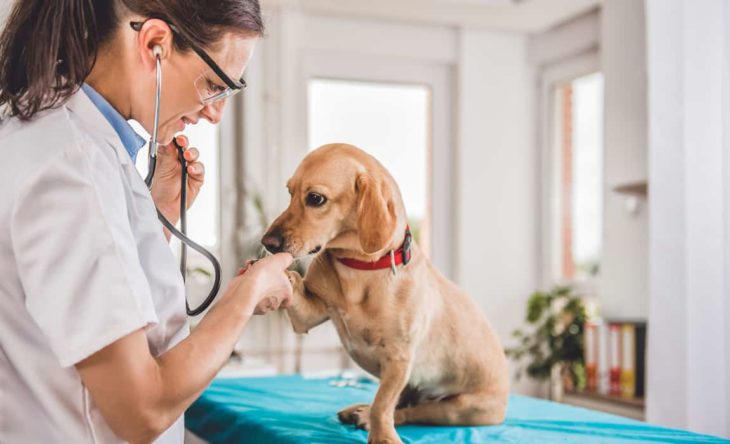As you might know already, there is a constant debate concerning what is the healthiest dog breed. And many debates about whether or not a purebred dog is healthy. Besides, plenty of people seem to believe that getting a mixed breed dog is the best solution. Before you join either one of those groups, you should know that, in reality, dogs are individuals. This means that even a purebred dog can experience serious health problems.
It is all about their genetic inheritance and their lifestyle. Moreover, you might even stumble upon a poor soul, which had an exemplary family history. However, the pet still gets some serious genetic problems. Overall, you have no way of telling with certainty that a dog will be healthy or not.
Still, what you can do is tend to your dog’s needs and focus on preventive care. In addition, having a little bit of extra care for some breeds or mixes with genetic predispositions to health issues might save you a lot of trouble in the long-term. For more useful tips of care your dog, you can find on thepets.net.
Generally, you should know that debating about which dog breeds are the healthiest is somehow unproductive. Similar to humans, our pets can or cannot inherit several health issues or genetic problems. In addition, many of those predispositions mentioned are less likely to occur in every pet of a specific breed. Either they represent small issues, or they affect all dogs of a particular breed.
Keep in mind that health issues can become severe and can have a negative impact on your pet’s quality of life. Knowing whether your dog is from a breed known for specific health problems can help you provide the best care for your furry friend. So, let us see up next to the top dog breeds that might (or might not) develop serious health problems. Keep in mind that this comparison refers to how often these breeds get sick when compare to other breeds or mixes.
Contents
Great Danes

Source: nhpr
The average life for a Great Dane is around eight years. This is a rather large breed, meaning their lives are notably shorter when compared to smaller breeds. Mainly, Great Danes are predisposed to bloat due to their vast chest cavity. In addition, this is a severe condition, as gas gathers in the dog’s stomach and twists it. In the end, this can prevent blood from flowing correctly and pose a severe risk for your dog’s health. Thus, emergency vet visits are a likely outcome so that you can safely overcome such life-threatening situations. Another common issue in this breed is dilated cardiomyopathy, which leads to a weakened heart muscle and the likelihood of having heart disease.
Akitas

Source: pettv
The average lifespan for Akitas is up to 15 years, depending on the care the dog receives. In addition, this breed can experience bloat. Still, Akitas tend to develop joint issues, meaning you should expect ligament injuries, especially if your dog becomes extremely active. Of course, several other dog breeds can also have this health problem, like Retrievers or German Shepherds.
French Bulldogs

Source: mentalfloss
A French Bulldog can live between 10 to 12 years. In addition, they became known for its wide array of health problems that occur because of their short nose. In most cases, a dog form this breed has a couple of respiratory issues, but specific congenital breathing issues can lead to additional vet bills. Besides, French Bulldogs might require expensive corrective surgical interventions, so that you can provide a better life quality for your furry friend.
American Pit Bull Terriers

Source: wikipedia
This breed can live up to 15 years and can turn out to be a great breed to have around, despite their appearing unpopularity. Still, this breed does not save you the troubles of unexpected health problems. They can experience hip dysplasia, a severe problem for this breed, which in most cases, will lead to emergency surgical procedures.
Rottweilers

Source: pets4homes
The average lifespan for this breed ranges from 8 to 10 years, and they are another breed likely to develop hip dysplasia. Besides this, Rottweilers are more likely to get cancer, especially at a young age. You should know that if caught early, cancer in this breed could be completely cured. Still, the surgical interventions and chemotherapy might turn out to be a significant additional expense for your household.
Doberman Pinschers

Source: anythingpawsable
Dobermans can live up to 13 years; still, they represent a breed predisposed to having dilated cardiomyopathy. Besides, this breed can develop cervical vertebral instability, along with a clotting disorder or various other heart health problems. Still, if you plan to get this breed, you should know there is a genetic test performed that can tell you whether or not your future pup has the gene responsible for the clotting disorder.
Bernese Mountain Dogs

Source: thetimes
This breed can have a shorter lifespan, and studies show the dog usually lives between 6 to 8 years. It is a large breed with the tendency of experiencing bone or joint issues, while cancer is not uncommon either. And, of course, dealing with such problems can take a toll on your financials.
German Shepherd Dogs

Source: pinterest
The normal lifespan of a German Shepherd is 13 years. This breed has a predisposition for several health problems, including orthopedic issues, degenerative myelopathy, epilepsy, eye issues, or digestive issues. Besides this, bloat is a common health concern in Shepherds.
Golden Retrievers

Source: bestprotectiondogs
One of the most prevalent breeds in the US, Golden Retrievers have a lifespan that ranges between 10 to 12 years. Still, recent studies revealed that more than 60% of these dogs end up dying due to cancer or tumors. In addition, as if this is not enough, this breed is extremely active and predisposed to the joint, knee, and hip issues. A frequent common in Retrievers is hip dysplasia. Therefore, if you are planning to get a Retriever, you should consider how you would care for him or her in case of an unexpected problem.
Bulldogs

Source: dogtime
A Bulldog can live up to 10 years, but it is considered to be one of the most expensive breeds concerning care and vet costs. This short-nosed breed is predisposed to respiratory issues. Besides this, they have awful hip and joint problems, which will require many vet appointments. Studies show that more than two-thirds of Bulldogs turn out to be dysplastic.
Thus, these are all exceptional dog breeds, but at the same time, they might end up requiring a lot of consideration and care from your part. You should not feel like you need to consider another breed because many dogs from these specific races can turn out to be extremely healthy.
Anyhow, if you are considering getting one of those dogs, you should research how to care for their potential health problems. In addition, you should know that the same genetics could be applied to mixed breeds, as they can inherit such issues.
Pet plans for specific breeds

Source: CBC
So, if you are contemplating getting a dog breed with a lot of potential for developing serious health problems, you should also take into account purchasing a pet plan. Besides, pet policies were created to aid owners in providing the best care for their furry friends. Moreover, because they have been around for quite some time now, we can clearly see more plans purchased in the US than never before.
Still, you should know that such policies differ from other types of insurances you might get. This means that a policy must meet your pet’s needs and you should look for a plan that offers features and amenities you can use in the future. Mostly, you will have to pay upfront and submit a reimbursement request with the provider, so that you will get part of your money returned. Also, some plans will have you meet a deductible before becoming eligible for reimbursement, while others function based on a co-pay. Overall, some companies can reimburse you up to 90% of the claim, but this depends on your policy’s particularities and the terms and conditions you agreed with your provider.
Many pet owners choose a standard plan and opt for including additional coverage for accidents or unexpected health issues. This means that they cover for primary care such as vaccines or exams, and the insurer offers reimbursement for expensive treatments. Still, you can opt for an extensive pet plan, which will include all sorts of preventive and wellness care costs.
The general rule says that the lower your deductible is, the higher the premium you will access. Those who have an extremely high deductible get lower premiums. Keep in mind that if you opt for a premium insurance plan, you will receive coverage for anything related to your pet care. However, this means you will have to cover for a higher monthly fee, too. Anyway, if you select a basic package, you can end up having an affordable pet plan, and access to coverage in case of serious scenarios.
Coverage and exclusions

Source: K9 of Mine
The most important thing you need to do when getting a pet plan is reading the terms and conditions referring to coverage and exclusions. Almost no pet plan will reimburse you for pre-existing health problems. However, you can still manage to find a couple of companies that might cover this situation, too. In addition, you need to request additional information about the annual deductible and its price. And, of course, how the benefit limit functions within the company.
Mainly, it would help if you did not settle on the first policy you stumble upon. It is always best to check customer testimonials and policy specifications with several companies. This can get you an accurate idea of how a provider deals with reimbursement requests and how this can help you in case of emergencies. In addition, to ease your quest, you can always use platforms such as PetInsuranceFinder. This website gets you to access a wide array of dog health insurance quotes from the most important pet insurance companies. Therefore, you will get the chance to compare prices, features, coverage, and limitations in one place.
Of course, such plans are not meant exclusively for high-risk breeds. You can get a plan for any dog or cat. It is always best to think about the future, as vet advancements are on the rise. Therefore, you will want to have the financial means to provide the best care for your furry friend, no matter the situation you both are in.
